|
|
|
Sort Order |
|
|
|
Items / Page
|
|
|
|
|
|
|
| Srl | Item |
| 1 |
ID:
166796
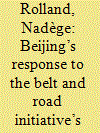

|
|
|
|
|
| Summary/Abstract |
Two speeches given by Xi Jinping in late 2013 – one in Kazakhstan, one in Indonesia – set the “Belt and Road Initiative” (BRI) in motion. What started as a continental Silk Road Economic Belt and a 21st century Maritime Silk Road embracing the Eurasian landmass from land and sea has since then expanded to include the African, South American and Oceanian continents, as well as the Arctic, space and cyberspace. The Belt and Road has become so ubiquitous in China’s external discourse and practice that it is now almost impossible to distinguish it from Beijing’s foreign policy.
|
|
|
|
|
|
|
|
|
|
|
|
|
|
|
|
| 2 |
ID:
166794
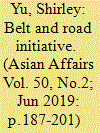

|
|
|
|
|
| Summary/Abstract |
In March 2013, a speech was given by Chinese president Xi Jinping in Astana, Kazakhstan, initiating the strategy of the ‘Silk Road Economic Belt’. In November 2013, a further speech was given by President Xi in Jakarta, Indonesia, launching ‘the 21st Century Maritime Silk Road’. Both speeches combined marked the birth of the grand strategic vision of the fifth generation of Chinese Communist leadership. This vision is commonly referred to as the Belt and Road Initiative.
|
|
|
|
|
|
|
|
|
|
|
|
|
|
|
|
| 3 |
ID:
166795
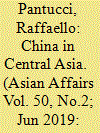

|
|
|
|
|
| Summary/Abstract |
In starting his announcement of the Belt and Road Initiative in Astana, Kazakhstan, President Xi Jinping was very consciously making the point that the broader vision of BRI was something that drew out of an approach that had been long developing between China and Central Asia. Focused on trying to improve prosperity at home through development and prosperity in adjacent regions, China’s relationship with Central Asia was one which provided a model that Xi saw as a positive way to articulate China’s foreign policy more broadly. Consequently, however, China’s relationship with Central Asia provides a useful window into understanding China’s broader Belt and Road Initiative. In the article, the author lays out a short history of China’s relations with Central Asia, illustrates their current status, before offering seven broader lessons and issues to be found which can provide a useful prism through which to consider the longer-term impact of the Belt and Road Initiative around the world.
|
|
|
|
|
|
|
|
|
|
|
|
|
|
|
|
| 4 |
ID:
166797
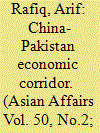

|
|
|
|
|
| Summary/Abstract |
The China-Pakistan Economic Corridor (CPEC) is among the more advanced Belt and Road Initiative (BRI) projects, with $18.9 billion in CPEC projects initiated or completed as of December 2018.1
1. ‘Latest Progress on the CPEC’. Embassy of the People’s Republic of China in the Islamic Republic of Pakistan, December 29, 2018, https://pk.chineseembassy.org/eng/zbgx/t1626097.htm (accessed 30 December 2018).
View all notes
Given the close strategic ties between Beijing and Islamabad, and the popularity of China among Pakistanis, CPEC serves as a valuable BRI case study, providing insights into how the programme has operated in a country with limited initial political barriers to Chinese aid and investment. China and Pakistan have had robust diplomatic and defence relations since the late 1960s. Economic ties have, however, remained weak. CPEC marked the start of a venture into unchartered waters with respect to the bilateral relationship.
|
|
|
|
|
|
|
|
|
|
|
|
|
|
|
|
| 5 |
ID:
166800
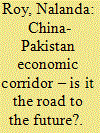

|
|
|
|
|
| Summary/Abstract |
In all of history, except for the Marshall Plan, there was practically no long-term project which needs enormous courage. Let me express my gratitude for the People’s Republic of China for this courage, and especially let me appreciate China’s president for the courage which is so rare.
|
|
|
|
|
|
|
|
|
|
|
|
|
|
|
|
| 6 |
ID:
166798


|
|
|
|
|
| Summary/Abstract |
Much ink has been spilled about China’s Belt & Road Initiative (BRI), President Xi Jinping’s grand vision for leveraging China’s growing wealth to expand economic, political, and military influence. The initiative is typically defined as encompassing projects in some 65 countries across three continents, and in sum it represents the greatest directed investment in history with an estimated value of over $1 trillion over the lifetime of the initiative.1
1. https://www.fbicgroup.com/sites/default/files/B&R_Initiative_65_Countries_and_Beyond.pdf (accessed 14 March 2019).
View all notes
But five years in, Xi’s “project of the century” is facing turbulence – from indications that China’s economy is slowing, routine construction and project management delays, and most interestingly efforts on the part of recipient countries to assert greater control over the direction of China's efforts.
|
|
|
|
|
|
|
|
|
|
|
|
|
|
|
|
| 7 |
ID:
166793


|
|
|
| 8 |
ID:
166799


|
|
|
|
|
| Summary/Abstract |
This article starts from the premise that today’s world is growing ever more chaotic. Poverty and the wealth gap are the most devastating sources of this chaos. As the old saying goes, “thieves are the children of poverty”. Poverty in a country is a potential source of international chaos, and the wealth gap has helped to trigger and worsen the chaos. A report released on January 18 2016 by Oxfam, an institution for poverty relief and development, shows that the wealth of the world’s 62 richest people is equal to that of the world’s poorest people, who account for half the total population of humankind. Moreover, the wealth of the richest 1% is more than that of the remaining 99% combined.1
1. Larry Elliott, ‘Richest 62 People as Wealthy as Half of World’s Population, Says Oxfam’. The Guardian, January 18, 2016, https://www.theguardian.com/business/2016/jan/18/richest-62-billionaires-wealthy-half-world-population-combined (accessed 9 March 2019).
View all notes
The world’s wealth gap has been increasingly widened, and the rich are getting richer at an ever faster rate.2
2. Winnie Byanyima, ‘Our Struggles for a Better World Are All Threatened by the Inequality Crisis’. Huffpost, January 20, 2016, http://www.huffingtonpost.com/winnie-byanyima/our-struggles-for-a-bette_b_9026582.html (accessed 9 March 2019).
View all notes
In this context, turmoil is no longer exclusive to less developed countries; it has been born in or spread to developed ones, as manifest in refugee crises, terrorist attacks, and the rise in extremism.
|
|
|
|
|
|
|
|
|
|
|
|
|
|
|
|
|
|
|
|
|